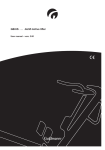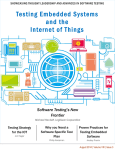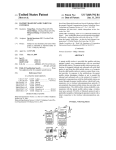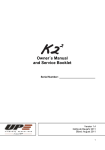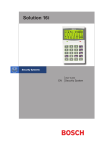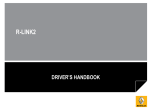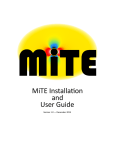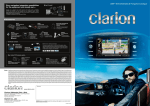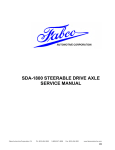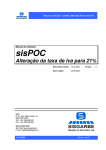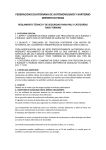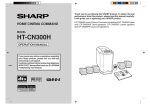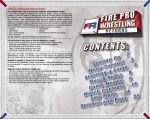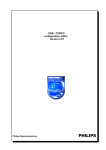Download Arbi ng Ma ers Too - Chess Arbiters` Association
Transcript
Arbi ng Ma ers Too Newsle er of the Chess Arbiters Associa on July 2015 Issue 9 Editorial The Women’s European Championship dominated the chess columns when accusaons of chea ng were made against one of the par cipants. In this case there does not seem to be any evidence to back up the claims. It will be interes ng to see if any ac on is taken against those who appear to have made false accusa ons. A FIDE Commission is about to inves gate Accelerated Pairing methods. It has been given a copy of the CAA method. My thanks to Gerry Jepps for his evalua on of the Vega pairing program. VEGA Pairing So ware 1 Introduc on Issue 6 of Arbi ng Ma ers contained a useful comparison of pairing programs by Alex Holowczak. This summarised the capabili es of Swiss Master, Swiss Manager and Tournament Director/UTU Swiss. Missing from the comparison was the Italian program Vega (h p://www.vegachess.com). This was a significant omission, although Vega is rela vely li le-known in the UK. This report aims to correct that omission and to evaluate its performance based on recent use at the May 2015 Frome Congress. This report does not aim to be comprehensive or to describe all of Vega’s capabilies. In par cular, no a empt has been made to evaluate Vega’s use for team tournaments or to exercise all the alterna ve pairing methods available. There is a much more complete descrip on in the Vega User Manual (h p://www.vegachess.com/ tl/tl_files/music_academy/distrib/vega_en.pdf) which also has plenty of screenshots of the user interface, which I have not reproduced in this report. 2 Vega Vega is the work of Luigi Forlano, a FIDE Arbiter, and is a FIDE endorsed tournament management program (h p://pairings.fide.com/approved-programs.html). It is widely used in Italy (obviously) but also in a number of other countries as diverse as Spain and New Zealand (where the na onal federa on insists that it must be used for all FIDE tournaments). The pairing engine for the Swiss (Dutch) system is Roberto Ricca’s JaVaFo, (h p://www.rrweb.org/javafo/aum/JaVaFo_AUM.html) which is the same pairing engine as that used by Swiss Manager. Possibly, the reason why Vega has had li le use in the UK is that un l recently the interfaces to the ECF grading system, although present, were not quite correct, rendering it unusable in prac ce. However, with version 7.1.6 (the current release) those interfaces are fully func onal and worked correctly when used for the Frome tournament. One advantage of Vega is that it is rela vely inexpensive. The Linux version is en rely free, whilst the Windows version is free for tournaments of up to 30 players. An unrestricted Windows licence is 50€. 3 Quick Comparison with other programs In issue 6 of Arbi ng Ma ers Alex Holowczak compared different tournament management programs using the following table. Copied below it is a bit hard to read and the original is slightly clearer in Arbi ng Ma ers.The colour code is that Green means the requirement is met fully, yellow means the requirement is par ally met and red means the capability is not present at all. Types of Tournament Vega Individual Swiss Individual All-Play-All Single or double round. Max 24 players Team Swiss Max 10 boards per team Team All-Play-All Single or double rd. Max 24 teams Impor ng Players for Tournament Vega Import players from FIDE ra ng list Import players from ECF grading list Either the web-site CSV text file or the graders’ master list (a er conversion to CSV format) Import players in bulk From any forma ed CSV file 2 Producing Pairings Vega Bri sh Pairing System Dutch Pairing System (FIDE) Also does Dubov Speed of Producing Pairings Quality of Presenta on Vega Website Presenta on Customisable Pairing Printouts Quality of Pairing Printouts Prints Result Slips with names Prints Match Cards with names Variety of other Printouts Ra ng Reports Vega FIDE-ra ng files ECF-grading files Note that the ECF Grading Checker has the func onality to covert FIDE-ra ng files into ECF-grading files. Usability Issues Vega Speed of adding players Adding byes in advance Changing default pairings Calcula ng variety of Tie-Breaks Player Limit 999 Round Limit 20 Other Vega Web Output Export PGN Files Licencing Vega Cost of Standard version Free Linux, 50 Euros Windows Number of Installs No prac cal limit 3 4 Evalua on 4.1 Preamble This evalua on should come with the caveat that this is the first tournament management program I have used, so I have no first-hand comment to make on how well usability compares with other programs. The comments below simply reflect whether the program did what I needed it to do and my impression of its fitness for purpose. The program was used at Frome for managing four sec ons, one of which was FIDErated. The tournaments were set up so that FIDE ra ngs were used for the Open and ECF ra ngs used for the other three sec ons. As this was the first me the Congress had used Vega, and it was to some extent a trial, Vega’s automa c pairings were used for the Open (but checked manually), whilst manual pairings were retained for the other sec ons (but the results management handled by Vega). All the player data, pairings and results were input into Vega for display on the Congress web-site and to generate the required grading/ra ng files. 4.2 Tournament Set Up & Player Input Ini ally se ng up the tournament (number of rounds, pairing system and e-break methods etc.) was quite simple and straigh orward. Inpu ng the players as the entries came in was also quite simple. The program comes ready configured to use the grading database that can be downloaded in csv format from the ECF web-site. This database can be used ‘as is’ without any modifica on, but is more limited than the graders’ master list. However, there is an op on in Vega to use any other customised database of choice. Since the graders’ master list was available, this was converted from Excel to csv format and used as the input database. To use the master list It was only necessary to define a ‘filter’ to tell Vega that (for example) the na onal ID was field 0, player name field 1, ECF grade field 5 etc. which was simple and straigh orward to do using the interface Vega provides for this purpose. The filter was set up to read in player name, ECF and FIDE codes, ECF grade and club code. The filter is a simple text file which I copied back to the program’s author and it has now been incorporated into the library of na onal filters supplied with the program. The ‘Federa on’ field in Vega was used to display club name for the non-FIDE rated sec ons, whereas for the Open this field was necessarily the 3-character FIDE federa on code. Dates of birth were read from the grading database in ECF format mm/yyyy), but necessarily had to be converted manually to FIDE format (yyyy.mm.dd) for the Open sec on. Any of the data fields in the input player list can 4 be manually edited. In par cular, FIDE ra ngs and FIDE tles had to be input by a manual edit as these are not contained in the ECF database. The op on to use any customised database would be especially useful when there is an exis ng set of players to be imported en bloc. One not-so-obvious ‘wrinkle’ is that a customised database has to use the semicolon character ‘;’ as the field separator and not the comma ‘,’ as is standard in the UK. Fortunately, the standard separator is customisable in the Windows control panel using the regional differences tab, and with that set appropriately Excel had no difficulty in saving the master list in the required format. Vega automa cally generated html files so that the evolving player lists could be displayed on the Congress web-site as the entries came in. Each player name was hyper-linked to their FIDE profile so data like current ra ng could be easily checked. There is a ‘player status’ se ng that allows byes or withdrawals to be pre-set. The player list has a coloured marker indica ng those players that will not be included in the next round’s pairings because of the player status se ng. Once player registra on is closed, the player list held by Vega is automa cally sorted into descending ra ng order and the first round pairings can be made. It is, however, possible to re-open registra on to cater for the unexpected very late entry (and we had one of those). 4.3 Pairings Automa c pairings are carried out in accordance with the Dutch system using the same pairing engine as that used by Swiss Manager. The automa c pairings used in the Open sec on worked just fine. The pairings were as I and (more importantly) the players expected. It is possible to ‘customise’ the automa c pairings to some extent, e.g. to avoid pairing two players from the same club. The pairings can also be modified manually or, indeed carried out completely manually. Manual input of the pairings that were generated the old-fashioned way using cards was quite quick and it was easy to correct any errors, swap colours, move pairings up and down the board order etc. Pairings (and other reports) can be passed to an in-built text editor. From that editor they can be printed directly or edited first (e.g. to change the point size of the printed text). 4.4 Ra ng Reports Vega generates both FIDE and ECF ra ng reports. Very li le manual edi ng of the files is required. 5 In the case of the FIDE ra ng file, the me control used has to be added manually. In the case of the ECF files, the Treasurer’s mul -line postal address, if required, has to be inserted manually as Vega will accept only a one-line email address. Also, the Event code is too restric ve in the number of characters allowed (6) [Version .7.1.8 now allows 10 character event codes] But these are compara vely trivial edits to the header informa on – the bulk of the results files are perfectly fine. Both the ra ng reports for Frome were submi ed the same evening as the Congress finished and both were accepted first me. 4.5 Web Site Genera on Web-site genera on is completely automa c, apart from the need to upload the ‘www’ folder. The style of web-site generated is best appreciated by looking at the Frome Congress web-site, i.e. h p://www.somersetchess.org/ frome_congress/2015/wwwFrome%20Open%202015%20%28Vega%29/index.html Player names in the cross-tables are hyper-linked to the player’s history card showing opponents, their grades, the results and the calculated player performance ra ng for the tournament. The la er is calculated according to ECF grading rules using the ECF grades. A nice feature is the ability to link to a pgn viewer for display of the games (see the link above for an example) 5 Conclusion I quite enjoyed using this program and it was definitely worth the effort required to gain familiarity with it. It did everything that I required it to do and I can thoroughly recommend it. An addi onal posi ve comment is that I have found the author Luigi Forlano to be very responsive to any comments received and helpful in implemen ng suggested bug-fixes/improvements. 1 In fact , Luigi Forlano now recommends his new program Orion for team tournaments h p:// www.vegachess.com/tl/index.php/downloaden.html 2 h p://www.newzealandchess.co.nz/NZCFdocs/VegaNZInstruc ons.pdf 3 The Vega User Manual says that when a player doesn’t have a FIDE ra ng the program will use the naonal ra ng instead. Rather than rely on that statement, and because it wasn’t clear how/if the program would convert between ECF and FIDE grades, I preferred to manually calculate the FIDE equivalent ra ng and insert it as an edit. There is a u lity to convert between FIDE and ECF grade/ra ngs (but one at a me not en bloc0. Gerry Jepps A lengthy ar cle which I hope will help others who wish to use pairing so ware. 6 FALSE ACCUSATIONS There is no doubt that chea ng occurs in chess. In my early days as an arbiter (so not exactly yesterday) a player was disqualified for going to the bookstall and checking on the opening line he was playing. Another received similar punishment when he went to the analysis room and the posi on on his board was discovered there. There was even an instance of a someone playing in place of a friend. The problem nowadays is that it is so easy to have, for example, a chess engine running on a phone that more people are increasingly suspicious that their opponent may be ge ng outside advice. Such suspicion took root at the recent European Women’s Championship in Chakvi, Georgia. The 45th seed, Romanian WGM Mihaela Sandu was leading on 5/5 when two le ers of concern were received by the organisers reques ng an -chea ng measures to be put in place. One of these le ers named Sandu. Sandu, a 2300 player had defeated an 1862 and then 4 2400 players. Whilst this performance was unusual it would not be correct to describe it as excep onal, parcularly when one game was won on me in an inferior posi on and another by a bad mistake by her opponent. Sandu lost in round 6 when transmission of her game and one other was delayed for technical reasons. She then won again in round 7, this me against a 2500. During the rest day which followed the situa on escalated. A le er was wri en and posted on the hotel no ceboard. The le er stated “We, the par cipants of the 16th European Women Championship would like to express our grave concern regarding raising suspicions of chea ng in the tournament. We would like to ask organisers coopera on in this regard. There are a few ways to fight with advanced technology, and we strongly believe organisers should do their utmost to avoid such situa ons. We have already asked for a 15 min delay in the live transmission of all games. It is a common solu on, used in many top level tournaments. If it is technically not possible, then we would like to ask organisers to propose another solu on of this problem for the remaining rounds of the Championship.” This le er was signed by 32 of the 98 par cipants. A second le er was signed by 15 players. It stated “We, par cipants of the 16th European Individual Women Championship, want to express concern about the situ7 a on with M.Sandu's performance. We would like to ask organisers not to include her games from the rounds 8-11 in a live transmission and publish them a er the rounds. We do not see any important reason to dislike this precau onary measure for both sides. We hope that such a decision will prevent all the possible suspicions.” Two players have subsequently asked for their names to be removed from the second le er. The tournament organiser stated that “we don’t share concerns of ‘rising suspicions of chea ng’ in this tournament”. In a reply to the second le er it was stated “A er consulta on with arbiters and also with grandmasters, organisers are sure, that there is not any par cular reason not to transmit the games of Mrs. Sandu. Grandmasters have checked her games with different programs and did not find any use of computer help during the game.“ “We consider this accusa on as unfair, insul ng and crea ng some psychological pressure. We think that both le ers should be seriously discussed in ECU to find the right way to protect players from advanved technology, so that not a single chessplayer is put under psychological pressure or undeserved insult. 8 Organisers ask those 15 players to show their respect to their colleague and to withdraw their signatures.” The player lost her remaining four games This case has been described as a witch hunt. It appears that there is no evidence that Sandu did anything wrong . As an arbiter I would want players to come to me if they had concerns about their opponent’s behaviour. Whilst I would not expect the players to necessarily be able to provide proof of their concerns I think I would expect them to claim more than just that the opponent was playing very well and therefore must be chea ng. FIDE requires the accuser to complete a form when making an accusa on. It also warns that ac on may be taken against those making false accusaons. I would not expect ac on to be taken against anyone expressing genuine concerns. As Chief Arbiter at norm bearing events I have had 5 accusa ons of electronic chea ng made to me. In three of the cases players were simply having a very good run and playing a bit above ra ng, in one of these an accused also had a medical condi on which meant he was absent from the board more o en than normal. In one case it was quite clearly a case of sour grapes by a GM losing to an un tled player. The fi h case remains one of some concern but is probably nothing more than a good run. Certainly, in only one of these would I consider sugges ng that ac on could have been taken against the accuser. In the case of the above tournament, it is one thing to ask the other opponents of a player if they shared your concerns. It is quite another to openly canvas for signatures accusing the player of chea ng. Bits ‘n’ Pieces Glasgow League Relega on in the top division of the Glasgow League, amazingly called Division 1, was decided by a decision of the Management Commi ee. There was a dispute between two teams in which every individual submi ed a different view of the 9 events. However all basically agreed the gist of the ma er which was that Player A was very short of me. Just before his flag fell he called out “Draw!”. His teammates interpreted this as an appeal under Appendix G.5 (the old 10.2—draw claim in the last 2 minutes) but the opposi on thought it was merely an offer to their player. Since it was generally agreed that the player was staring into space rather than at the opponent when he made the call the decision of the ManComm was that it was a claim rather than an offer and the draw was awarded. NE England Megafinal The regional heats of this schools’ tournament through up an interes ng li le problem. In round 5 of one of the Girls’ sec ons one player had already scored the 4 points needed to progress, her schoolmate opponent was on 3. The player on 3 points won with Fools Mate. White’s me 6 seconds, Black’s me 0 seconds. On being told that the result of prearranged games was 0-0 the players argued that it had not been pre-arranged. The arbiter then said that they could be accused of bringing the game into disrepute and that the result of that would also be 0-0. It was agreed that a proper game should be played which Black eventually won. ARBITING MISTAKES? Almost every arbiter will admit to either having made a mistake or of wishing they had handled a situa on differently. Here is one where the arbiter’s decision affected the outcome of the US Championship. The game in ques on was played in New York, April 17, 1942 between Samuel Reshevsky and Arnold Denker. Chess Review reports “When Tournament Director (L Walter) Stephens forfeited Denker for overstepping the me limit in the … game from the sixth round, the crowd demonstrated its disapproval with boos and jeers.” Another player, Kashdan, described it as “a near riot”. Tournament Director is the American term for arbiter. The story is that Denker claimed a win on me. The arbiter arrived at the board behind the clock, li ed it up and turned it round to look at it. This ac on put the 10 clock with the expired me at Denker’s side. Stephen’s declared Denker to have lost. Reshevsky apparently did not correct the error. Denker put in a protest which included a complaint that the clock had no flags and that his opponent was not recording. It is likely that Reshevsky was not recording for religious reasons but under US Rules that would have prevented him from claiming a win on me. The arbiter is quoted as saying "Does Kenesaw Mountain Landis (a tyrannical baseball Commissioner of the day) ever reverse himself?". The protest was disallowed. The game and final posi on which is generally regarded as drawn follows. 1. d4 Nf6 2. c4 e6 3. Nc3 Bb4 4. a3 Bc3 5. bc3 c5 6. e3 O-O 7. Bd3 d5 8. cd5 Qd5 9. Nf3 cd4 10. ed4 b6 11. c4 Qd6 12. O-O Bb7 13. Ne5 Nc6 14. Bb2 Rfd8 15. Nc6 Qc6 16. f3 Rac8 17. Qe2 Qd6 18. f4 g6 19. Rae1 Re8 20. Rf2 Nh5 21. Qg4 Ba6 22. Rc1 Re7 23. c5 bc5 24. Ba6 Qa6 25. dc5 Rec7 26. Qg5 f6 27. Bf6 Nf6 28. Qf6 Rc5 29. Rc5 Rc5 30. Qd8 Kf7 31. Qd7 Kf8 32. h3 Qb6 33. Kh2 Rc1 34. Re2 Qg1 35. Kg3 Rc3 36. Kh4 Qc5 37. Qh7 Qe7 38. Qe7 Ke7 39. a4 Kf6 40. Re4 Ra3 41. g4 a5 42. Rc4 Rf3 43. Rc5 Rf4 44. Ra5 g5 45. Kg3 Rb4 It therefore appears that Reshevsky scored at least ½ point more than he should have from the game. This was to be decisive . Reshevsky eventually won the 1942 U.S. Championship, but only a er some further adventures, including a ebreaking match with Kashdan. As for poor Denker, he finshed ed with Pinkus in 34th place, 2 points behind Reshevsky and Kashdan. Denker refers to the incident in his book ‘My Best Games 1929-1976’ "Toward the end of the me control, the maddest me scramble in which I have ever par cipated, took place. In the excitement, the Tournament Director forfeited me by mistake. On being informed of his error, he replied tartly, "Does Kenesaw Mountain Landis ever reverse himself?!" So my hopes of the tle went glimmering. I drew two morals from this outcome. One is the realiza on that important tourna11 ments should be fully staffed, so that officials are not handicapped in the performance of their du es. Second was a determina on to avoid me trouble in the future. The spirit is willing, but the flesh is weak." TOP 10 EXCUSES GIVEN TO ARBITERS FOR LOSING 1. 2. 3. 4. 5. The ba eries died in my hidden receiver I got lost on my way back from the hotel (genuine!) Lost too much me hiking to the smoking area (genuine but said as a joke) Lost too much me pondering over the latest ECF/CAS legal case A er making a move I punched my opponent instead of the clock 6. Studied “How to Beat Bobby Fischer” but was unprepared for other opponents 7. The WC cubicle with my mobile and its chess app in it was always occupied 8. The arbiter reject my draw claim just because my flag was down 9. Wrote a note to myself telling me not to write notes to myself 10. Dog ate my scoresheet so arbiter defaulted me for refusing to score You are the arbiter What happens if the 75th move without a capture or pawn move is mate? Is it a draw, does the mate count or should the arbiter record the score as ½ - 1? Would it make a difference if the mate came on move 76 but before the arbiter stepped in? Answer on Page 15. 12 Wesley So Postscript So lost a game in the US Championship a er making notes not directly related to moves but to help him concentrate. Some players felt this was a bit harsh. The problem with a player making notes is that it could be impossible to establish their real significance. Squiggles could be designed to disguise a move being analysed. It was not always illegal to make notes during a game. Dr Savielly Tartakower (1887 -1956) the Polish and French player of Grandmaster strength for example was well known for wri ng during his games. Tartakower a leading journalist and author in the 1920s and 30s is believed to have annotated his columns whilst playing. Leonard Barden gives an anecdote about his note making at Southsea in Chess Notes 6990 on ChessHistory.com FIDE & Pairing Rules At one me it was acceptable to alter pairings to create norm chances. This has not been the case for some me and though FIDE have recommended pairing systems they have not insisted that these be used. It has been acceptable to indicate which pairing system was used. However, in future it may be that FIDE will insist that in norm events the draws can be checked by computer. If this does come to pass then the CAA pairing system would need to be submi ed to FIDE for approval if it were to be used. This would almost certainly require it to be wri en as a so ware program. Is there anyone willing to a empt this not inconsiderable task? FIDE is also looking at producing so ware to do accelerated pairings. The appropriate FIDE Commission will consider the CAA method towards the end of this year. This system would not necessarily be restricted to the Bri sh system but would work equally with the current Dutch Pairing System which is favoured by many. Accelerated pairing systems do come under considerable cri cism, some more so than others. I believe FIDE are trying to remove acceptability from some of these systems. 13 Targe ng the Arbiters American GM Grigory Serper produced a column on Chess.com en tled “Do Arbiters Know The Rules Of Chess?”. In it he complains about the number of arbiters he has encountered who have made mistakes. This, he says, is par cularly prevalent in scholas c tournaments in the United States. The situa on in the States is made more complicated by using either the FIDE Laws and the USCF Laws depending on the tournament. It is not surprising that players and arbiters get confused, despite recent a empts to bring the two codes closer together. Serper also claims that he teaches his students about the most common errors that arbiters will make. In his ar cle he talks about the infamous K+N v K+N Armageddon game from the Women’s World Championship in which one of the players was flagged out. The arbiters originally gave the result as a draw to be overruled by the Appeals Commi ee. He then equates this to an incorrectly made repe on claim by an opponent of his. If his account is correct the arbiter wrongly allowed the claim to be inves gated a er the player had made his move which repeated the posi on instead of wri ng it down. (This procedure of prewri ng a move leading to a claim is o en cri cised by players but is intended to give them protec on from the unscrupulous opponent who will simply reply to the drawing move and argue that no draw claim was made at the me.) Again the Appeal Commi ee decided against the arbiter and the game con nued later the same day. Obviously this was unsa sfactory. Any delay in a game should be avoided if possible. It is easy to knock arbiters. In both of the above cases it was implied that arbiters were inven ng their own ‘spirit of the law’ rules rather than the actual wording. I admit that on a couple of occasions when a draw claim had beenmade and the game had con nued un l flag fall I have tried to persuade a player to accept the draw claim offered in the last two minutes. On those occasions I had no doubt that had the claiming player had another minute any doubt about the result would have disappeared. But when the opponent has refused to accept this I have had to award the win as I felt that a couple more moves needed to be played to demon14 strate beyond any doubt that the claimant would hold the posi on. O en in Britain when mistakes are made they are by non-qualified people calling themselves arbiters. Players do not differen ate. We should all urge unqualified friends to a end a course and get qualified. (Details of courses are on the website.) Loss on Time—The Origins? The current laws has introduced the possibility of fining players for offences. To many this seemed revolu onary but in fact was not uncommon in the 19th century. It would be reasonable to assume that a loss on me came into existence at the same me as ming devices were used. The first ming devices, which were sandglasses, gained popularity in the 1860s. However a loss was not the recognised penalty then. Ini ally a player exceeding the me allowed would be fined for the offence. The London Interna onal tournament of 1883 pioneered the use of the dual chess clock in a single apparatus. The rules of the London event also provided that a player exceeding the me limit forfeited the game. This was rela vely novel at the me but therea er gained in popularity. You are the Arbiter Answer The Laws state that checkmate immediately ends the game. It does not say the same about the 75 move rule. This should be given as a mate. In the second case the arbiter should should check that 75 moves have been played without a capture or pawn move by both sides before the mate was played. If that is the case then the draw should be awarded. 15 Bri sh Arbiters Abroad Both Lara Barnes and Alex McFarlane have been invited to officiate at the World Youth Under 16 Olympiad in Ulaanbaatar, Mongolia. Alex has been appointed as the Chief Arbiter and will also conduct a FIDE Arbiter course when there. Forsyth Nota on A draw has been claimed in this posi on. You have to move the players some distance to check the claim. It is therefore necessary to note down the posi on. There is no diagram blank readily available so what do you do? The simple answer is to use Forsyth nota on to make a note of the posi on. Star ng at a8 we record as follows with upper case for White and lower case for the Black pieces. Empty squares are numbers. This gives: 3r2k1/5ppp/p1b5/Pp6/1P6/2P5/2B3PP/5RK1 The originator of this concept was David Forsyth (1854-1909). He showed his idea to friends who persuaded him that it deserved a wider audience so an explana on was given in the Glasgow Weekly Herald of 10th February 1883. A copy of the column is given on the next page. When Forsyth was Treasurer of the Sco sh Chess Associaon he would give players a chess problem to solve on the back of their receipts of membership. The posi ons were, of course, given in his nota on. Steven J Edwards extended this to be supported in use by computers. This is Forsyth Edwards Nota on or as it is more commonly recognised FEN. This is an integral part of Portable Game Nota on files (pgn). Only in the U S of A (1) I believe the following to be factual. A poten al player contacted an organiser in Kentucky asking for confirma on that it was OK for an ‘open weapon’ i.e. a gun which was visible to anyone to be present at a chess tournament. The player himself was not going to have it but it would be in 16 the possession of his body guard. The request was denied on the grounds that the gun could be seen as an in mida ng influence on the opponent. It could therefore poten ally give the person with the gun a psychological advantage. The organiser then sought advice from others that he had acted correctly!!! One of the replies men oned that a TD (Tournament Director, the American term for an arbiter) he knew had carried a gun with him and when anyone had a dispute about the rules he would display it. He went on to say that that person’s events had few disputes. Most said that it was the correct decision, but one person suggested that tournaments where people had guns were actually safer. Several stated that having an open gun was more threatening but probably less dangerous than having players with concealed weapons. Can you even imagine discussing this in Britain? 17 Only in the U S of A (2) The US Open to be held in Arizona was under threat un l recently due to a legal challenge. It would appear that someone who was prevented from organising for profit poker tournaments because of the States gambling laws started a legal ac on which, if successful, could have affected the structure of the event. It would appear that the poker organiser was unsuccessful. One of the reasons being that the USCF would not make a profit from the event (a Governance mee ng being held with it would ensure that there was no surplus). Quote … Unquote Vladimir Kramnik “I believe that it is necessary to introduce a rule: if there are not some kind of an -chea ng measures, the tournament is simply not counted. So, if it is an open, people come and play for money, without any ra ng gains or losses, and that's that.” FIDE Arbiter Title Currently an arbiter can be licenced with FIDE from the age of 18 but you cannot become a FIDE Arbiter (FA) un l the age of 21. The Welsh Chess Union have put a proposal to FIDE that it should be possible to become an FA at the age of 18. This proposal is supported by the ECF and Chess Scotland. To gain the tle an arbiter must obtain three norms from tournaments and a 4th norm from successfully comple ng a course. Bri sh arbiters recognised by FIDE to conduct these courses are Alex McFarlane, Stuart Reuben, David Sedgwick and David Welch. Times Past A ached is part of an entry form from the 1975 Birmingham Weekend Chess Fes val. The prizes have not changed much in the following 40 years but the entry fee was only £5. The event was held at the Royal Angus Hotel from Friday 21 to Sunday 23 March, 1975. The arbiters (or controllers as they were referred to) were W. Ritson Morry (FIDE), J.H. Baines and D.D. Collman. The Tournament Secretary was K.G. Humphreys. The closing date for entries was 12 March. The suppor ng events make interes ng reading. The me control of 50 moves in 2 hours and 10 moves in each addi onal 5 minutes could have meant several clock manual resets in a long game. 18 19 Chess Arbiters Association laws of chess for League captains ? Annual General Meeting (5) Should the CAA seek to have great- 1845 hours Sunday 2nd August 2015 er influence over decisions taken by FIDE ? Warwick University (6) After attending the 'World Youth Championships' In South Africa there • Apologies for absence was a failure by the organisers to pay Guest speaker-to be confirmed (10 the arbiters. Should the CAA have an minute presentation) agreed rate for English events ? • Minutes of the previous AGM(7) Should the CAA have basic fees Attached which should be recommended to • Matters Arising- event organisers i.e. Hotel accommoSubjects for discussion dation, £0-45p mileage and £25-00/day (1) Should all arbiters to become rec- subsistence ognised by FIDE • Chairperson’s Report-Lara Barnes (2) Has the CAA outlived its usefulness • Secretary’s Report-Alan Ruffle and if so should it continue ? • Treasurer’s Report-Tony Corfe • Election of Officers (3) Should there be revision courses for • Date of next meeting experienced arbiters ? (4) Should there be seminars on the Items for inclusion in future issues should be sent to Alex McFarlane [email protected] 20




















